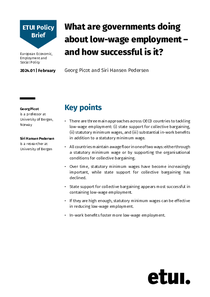What are governments doing about low-wage employment – and how successful is it?

Picot, Georg ; Hansen Pedersen, Siri
European Trade Union Institute, Brussels
ETUI - Brussels
2024
9 p.
low wages ; employment ; minimum wage ; collective bargaining ; government policy
ETUI Policy Brief. European Economic, Employment and Social Policy
2024.01
Wages and wage payment systems
English
Bibliogr.
2031-8782
"Key points:
• There are three main approaches across OECD countries to tackling
low-wage employment: (i) state support for collective bargaining,
(ii) statutory minimum wages, and (iii) substantial in-work benefits
in addition to a statutory minimum wage.
• All countries maintain a wage floor in one of two ways: either through
a statutory minimum wage or by supporting the organisational
conditions for collective bargaining.
• Over time, statutory minimum wages have become increasingly
important, while state support for collective bargaining has
declined.
• State support for collective bargaining appears most successful in
containing low-wage employment.
• If they are high enough, statutory minimum wages can be effective
in reducing low-wage employment.
• In-work benefits foster more low-wage employment."
Digital
The ETUI is co-funded by the European Union. Views and opinions expressed are however those of the author(s) only and do not necessarily reflect those of the European Union or the ETUI.